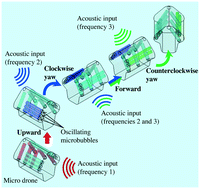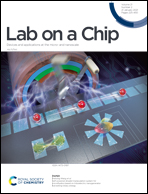3-D swimming microdrone powered by acoustic bubbles†
Abstract
Mobile microrobots that maneuver in liquid environments and navigate inside the human body have drawn a great interest due to their possibility for medical uses serving as an in vivo cargo. For this system, the effective self-propelling method, which should be powered wirelessly and controllable in 3-D space, is of paramount importance. This article describes a bubble-powered swimming microdrone that can navigate in 3-D space in a controlled manner. To enable 3-D propulsion with steering capability, air bubbles of three lengths are trapped in microtubes that are embedded and three-dimensionally aligned inside the drone body using two-photon polymerization. These bubbles can generate on-demand 3-D propulsion through microstreaming when they are selectively excited at their individual resonance frequencies that depend on the bubble sizes. In order to equip the drone with highly stable maneuverability, a non-uniform mass distribution of the drone body is carefully designed to spontaneously restore the drone to the upright position from disturbances. A mathematical model of the restoration mechanism is developed to predict the restoration behavior showing a good agreement with the experimental data. The present swimming microdrone potentially lends itself to a robust 3-D maneuverable microscale mobile cargo navigating in vitro and in vivo for biomedical applications.



 Please wait while we load your content...
Please wait while we load your content...